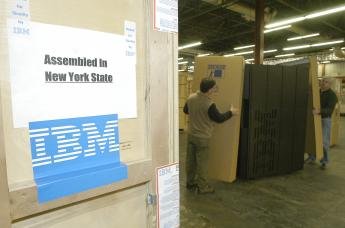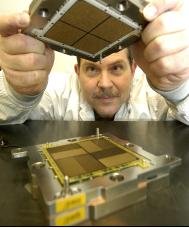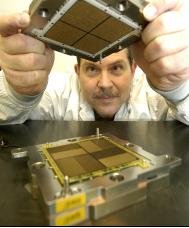- Big leap in capacity reduces pressure on over-taxed, out-of-power data centers
- Single z10 equal to nearly 1,500 x86 servers
- Up to 85% less energy costs
- Up to 85% smaller footprint
- Consolidates x86 software licenses at up to a 30-to-1 ratio.
- Mainframe goes Quad-Core
- z10 brings discipline to data center chaos:
- Just-in-time capacity to meet ever-changing business conditions
- Automated management of system performance to favor high-value transactions
IBM today announced the System z10 mainframe to help clients create a new enterprise data center. The system z10 is designed from the ground up to help dramatically increase data center efficiency by significantly improving performance and reducing power, cooling costs, and floor space requirements. It offers unmatched levels of security and automates the management and tracking of IT resources to respond to ever-changing business conditions.
In addition to the z10, IBM also announced it has invested $300 million in architects, technical skills, as well as design and benchmarking centers to help clients transform to a new enterprise data center. Qualified clients can receive free assessment services to prioritize and take action to implement a more efficient, shared and dynamic IT infrastructure.
IBM s next-generation, 64-processor mainframe, which uses Quad-Core technology, is built from the start to be shared, offering greater performance over virtualized x86 servers to support hundreds to hundreds of millions of users.*1
The z10 also supports a broad range of workloads. In addition to Linux, XML, Java, WebSphere and increased workloads from Service Oriented Architecture implementations, IBM is working with Sun Microsystems and Sine Nomine Associates to pilot the Open Solaris operating system on System z, demonstrating the openness and flexibility of the mainframe.
From a performance standpoint, the new z10 is designed to be up to 50% faster and offers up to 100% performance improvement for CPU intensive jobs compared to its predecessor, the z9, with up to 70% more capacity. * 2 The z10 also is the equivalent of nearly 1,500 x86 servers, with up to an 85% smaller footprint, and up to 85% lower energy costs. The new z10 can consolidate x86 software licenses at up to a 30-to-1 ratio. *3
Hewitt Associates, one of the world s foremost providers of human resources outsourcing and consulting services, uses z10 mainframes as a cornerstone of its operations. "We ve implemented z10 systems in our parallel Sysplex environment, which is running live, mission-critical benefits applications for the world s top employers - so availability, performance, and reliability are of utmost importance," said Sandee Kotowski, manager of mainframe infrastructure, Hewitt Associates. "The IBM mainframe has been a key part of our IT infrastructure over the years, with clear cost benefits, but this new system takes that value proposition a leap ahead. The capacity and scale of this system changes the economics of the mainframe and is a significant step forward in addressing our constantly evolving technology needs."
Designed as Engine to Manage IT as a Service; Drive the New Enterprise Data Center
Businesses are working to not only greatly reduce the inefficiency and complexity of today's data centers, but also share IT resources more efficiently and better align them to specific business objectives and ever-changing business conditions.
At the same time, they are grappling with how to log, track, audit, and charge back every business transaction. Their end objective is to move beyond basic virtualization (in which different computing tasks are partitioned on a server) to an environment in which their entire IT infrastructure, including business applications, security, storage, processing power, etc., is provisioned on demand.
The end result is that businesses can manage IT as a service -- using a policy-driven system that doles out, manages, and tracks appropriate IT resources where and when needed -- to create the new enterprise data center.
The z10 is the industry s only server providing a complete range of policy-driven functions, including:
Authorization Management to authenticate and authorize who can access specific business services and associated IT resources. Designed with encryption algorithms, the built-in features allow for System z10 administrators to dictate multiple layers of security and security clearance to allow authorized users to access sensitive information that resides on the System z. For example, an employee with entry-level clearance to search employee records for histories of volunteer work for a corporate report might not be able to access salary, promotion, and HR information for those same employees -- based on the level of access that employee has been given as part of the authorization management policies built into the System z.
Utilization Management to drive maximum use of the system. Radically different from other classes of servers, the System z10 is designed to run at up to 100 % utilization - based on the varied demands placed on it by users.
z/OS, one of the operating systems for the z10, can manage transactions based on preset policies, adjusting on the fly to peaks and valleys. For example, customers going to a bank have multiple needs - some need cash - which is an instantaneous response, while other are applying for a mortgage - which is a longer process. The mainframe and the integrated OS can be configured to decide which requests are mission critical and timely and allocate utilization based on these needs.
Just-in-Time Capacity to deliver additional processing power and capacity when needed to help businesses better manage risk (e.g. more computing power during a peak retail season).
For the first time, the 64-processor z10 will automate the provisioning of processing power when needed to address changing business conditions. For example, financial services and retail institutions can schedule and automatically provision pre-set levels of processing power to manage spikes in demand. Equally as important, the z10 can also automatically provision processing power when unanticipated demands hit.
z/OS anticipates when additional capacity is needed, for how long, and maps to that instantly. This is known as "Just-in-Time Deployment of Capacity Resources." The feature is built upon transaction needs and how customers prioritize them.
Virtualization Security with the U.S. government's highest level of security, Evaluation Assurance Level 5 (EAL5), via z/VM. The IBM System z is the only server on the planet that has achieved this level of certification for security and partitions (through the System z9 with plans in place to apply for EAL5 for the System z10). When customers are looking to allocate additional resources in the mainframe and partition them to save money and access capacity on demand, the EAL5 certification states that the virtual partitions that are opened running the specific operating systems are in effect the same as if you were running another server connected to the System z - the physical security for the virtual partition is the highest level it can be. This enables customers to allocate resources on demand, without fear of security risk to any of the information running through the operating systems, improving performance and enabling 24/7 availability.
System z Skills Continue to Rapidly Expand around the World with IBM Academic Initiative, Tied to Mainframe s Resurgence; New Rational Tools Drive Continued Ease of Use
Launched in 2004, the IBM Academic Initiative offers a wide range of technology education benefits through IBM s deep technology capabilities and experience - from IBM supplied instruction to technology -- that can scale to meet the goals of colleges and universities around the world.
Academic Initiative: System z works with schools to enable courses, labs, senior design projects, and research in large systems thinking. IBM today announced a new milestone as it topped the 400th University participating in the program around the world (up from 23 universities in the program in 2004). The news demonstrates the dramatic growth of the program tied to the resurgence of the mainframe in the data center (see separate press release on today s Academic Initiative news).
In addition, as part of IBM's $100 million Mainframe Simplification investment announced in 2006, IBM today announced new Rational software for System z to speed the deployment of applications running on System z and continue to drive ease of use. For example, the new Rational software translates COBOL applications into Web services eliminating the need for new developers to learn the COBOL programming language. (see separate press release on today s Rational software news).
Also as part of IBM's Mainframe Simplification investment, IBM today announced a new set of software that automates the management of complex IT disciplines (such as storage, databases and new software deployments) and delivers a single, integrated view of the impact on critical applications hosted on customers' mainframes. The IBM Tivoli Service Management Center for System z shows the linkages between IT assets and business applications and enables enterprises to monitor the overall service delivery from IT in support of specific business objectives in finance, security and customer satisfaction, among others. (see separate press release on today's Tivoli software news).
New Information on Demand Software for System z
IBM today is announcing new Information on Demand software for System z, including Cognos 8 Business Intelligence (BI) for System z. IBM Cognos 8 BI for System z combines the proven reporting and analysis capabilities of IBM Cognos 8 BI with the power and reliability of System z, enabling customers to use their data for competitive advantage, improve decision-making and optimize their business performance. IBM is also announcing a Cognos 8 BI for Linux on System z customer beta program. IBM Cognos 8 BI for Linux on System z will be available in the second half of 2008.
IBM s Information on Demand strategy is helping customers gain access to the right information they need, when they need it, along with key business insights needed to address and respond to changing market demands. By deploying Cognos 8 BI for Linux on System z, customers will be able to easily report and analyze hundred of millions of transactions directly on the mainframe - ensuring everyone across the organization can quickly identify and respond to critical business trends.
IBM is also announcing the immediate availability of DB2 for z/OS Value Unit Edition, which provides a new one-time-charge offering that enables the deployment of new application workloads. This offering strengthens the role of System z as a cornerstone for key business initiatives such as SOA, Data Warehousing, Business Intelligence and packaged applications such as SAP. DB2 for z/OS Value Unit Edition and IBM Information Server enable System z clients to further deliver trusted information for their dynamic warehousing requirements.
In addition, IBM will bring new Master Data Management capabilities to System z in the second half of this year. This will include the InfoSphere Master Data Management Server for Linux on System z, which allows businesses to centrally manage customer, product, and account data for use across an enterprise.
Customers can contact their IBM or Cognos Sales Representative to get more information about participating in the Cognos 8 BI for System z beta program.
New Attached Storage Offerings Help Optimize Mainframe Environments for Managing Information
Transactions, information, and data are growing by leaps and bounds, creating challenges for storing and accessing information efficiently. Today, IBM is introduced enhanced storage capabilities for mainframe environments that help optimize information availability, mitigate information risks and maximize information storage capacity for very large amounts of data.
Enterprise Disk Storage: Delivering the industry's leading mainframe storage solution, IBM is announcing an enhanced version of its enterprise disk storage solution -- DS8000 R3.1 -- with new disaster recovery and business continuity features that optimize the power of the mainframe. Working in concert with the IBM z/OS 1.10 operating environment, customers can now manage up to four times more information in their mainframe environments than with any other storage system.
Enterprise Tape Virtualization: Building on almost 40 years of virtualization expertise, IBM also enhanced the IBM System Storage TS7700 Virtual Tape solution for mainframe environments, delivering improved information retention, archiving and security capabilities through exploitation of IBM's TS1120 tape encryption solution.
IGF Financing for the z10
IBM Global Financing (IGF), the leasing and lending business segment of IBM can offer financing terms and conditions that in many cases, can make it possible for qualified clients with existing IGF z9 leases to acquire the new IBM System z10 and its increased computing power at a lower monthly payment than they currently make today. For more information visit www.ibm.com/financing.
New IBM IT Transformation & Optimization Consulting Services for New Enterprise Data Center
IBM also introduced several new services today which complement its existing strength in aligning data center transformation strategies and design with implementation and ongoing management. IBM IT Transformation & Optimization Consulting Services, a strategy and planning consulting service, provides a pragmatic approach to helping clients by building an overall business case for demonstrating the business value and return on investment of their IT infrastructure. IBM Implementation Services for Parallel Sysplex Middleware leverage the System z as a consolidation point for data to help clients move to a centralized DB2 data sharing environment while protecting data integrity. IBM Implementation Services for Geographically Dispersed Parallel Sysplex (GDPS) enables a unique integrated and automated end-to-end recovery solution across System z and other platforms.
For additional information please visit www.ibm.com/datacenter.




